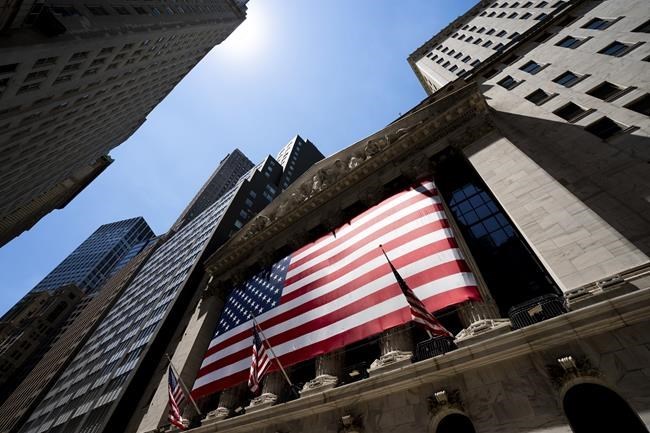NEW YORK (AP) ŌĆö Stocks drifted to a lower close as Wall StreetŌĆÖs red-hot rally this year cooled a bit more. The S&P 500 slipped 0.3% Thursday, its third straight loss. The Dow fell 66 points, or 0.2%, and the Nasdaq composite lost 0.1%. Treasury yields in the bond market continued to march higher, putting more pressure on the stock market. Yields have climbed as the economy has remained remarkably resilient despite much higher interest rates meant to drive down inflation. Reports on Thursday indicated a still-solid job market and still-growing services industries. A more impactful report on jobs will arrive Friday.
THIS IS A BREAKING NEWS UPDATE. APŌĆÖs earlier story follows below.
NEW YORK (AP) ŌĆö Stocks are drifting Thursday as Wall StreetŌĆÖs red-hot rally for the year cools a bit more.
The S&P 500 was 0.3% lower in late trading after teetering between small gains and losses through the day. It's on pace for a third drop after setting a 16-month high.
The Dow Jones Industrial Average was down 64 points, or 0.2%, at 35,217, as of 3:15 p.m. Eastern time, and the Nasdaq composite was 0.2% lower.
A day earlier, U.S. stocks tumbled to their worst loss in months. While the drop came after , analysts say they expect the move to mean little for financial markets. U.S. Treasury debt is the cornerstone of the global financial system, but the downgrade likely wonŌĆÖt push any investors to dump theirs.
The big questions remain whether the economy will avoid a recession, how corporate profits will do and where interest rates are heading. Hanging over them all is whether the stock marketŌĆÖs big run this year was overdone, as critics suggest.
Treasury yields in the bond market continued to march higher Thursday, putting more pressure on the stock market. The yield on the 10-year Treasury rose to 4.19% from 4.09% late Wednesday and from 2.75% a year ago.
Higher yields mean bonds are paying more in interest, which can peel buyers away from stocks. They also make borrowing more expensive for companies, crimping their profits.
Yields have climbed as the economy has remained remarkably resilient despite much higher interest rates meant to drive down inflation. The U.S. government also continues to borrow heavily.
In the latest reading on the economy, a report showed that but remains relatively low.
A solid job market has helped to keep the economy out of a long-predicted recession. But it also threatens to keep upward pressure on inflation. That could push the Federal Reserve to keep raising interest rates, dashing Wall StreetŌĆÖs hopes that the last hike of the cycle has already been put in place.
ŌĆ£The Fed has singled out the jobs market as a potential inflationary threat, and until it shows some signs of deterioration, weŌĆÖre still looking at a ŌĆśhigher for longerŌĆÖ outlook for interest rates,ŌĆØ said Mike Loewengart, head of model portfolio construction at Morgan Stanley Global Investment Office.
The Fed has hiked its federal funds rate to the highest level in more than two decades, up from virtually zero early last year. High rates grind down inflation by bluntly slowing the entire economy and dragging on prices for investments.
Critics say a consensus has formed too quickly on Wall Street that inflation will continue to moderate and that the Fed can not only halt its hikes to rates but even begin cutting them early next year.
Across the Atlantic, again to a 15-year high and indicated it could stay high for a while. That followed a move last week by the Bank of Japan that could allow longer-term interest rates there to rise.
In separate reports Thursday, one from the Institute for Supply Management said growth in the U.S. economyŌĆÖs services industries continued last month, though at a slower rate than economists expected. Another report from S&P Global also said growth is slowing for services industries, pointing to customers contending with the more expensive cost of living and higher interest rates.
Earnings reporting season also continues for big U.S. companies. The majority have reported better results for the spring than expected, but thatŌĆÖs usually the case and expectations were quite low coming into this quarterŌĆÖs season.
Qualcomm tumbled 8.7% for one of the larger losses in the S&P 500. It reported weaker revenue for the spring than expected, even though its profit topped forecasts.
On the winning side was Clorox, which jumped 8.8%. It reported stronger profit and revenue than analysts expected.
Stocks of energy producers were also stronger, and Exxon Mobil gained 1.9%. They benefited as crude prices rallied after Saudi Arabia said it will keep in place cuts to production meant to boost oil's price.
Two hugely influential companies will report their results after trading ends for the day. Apple and Amazon are two of the largest companies on Wall Street by market value, which gives their stock movements more heft on the S&P 500 and other indexes.
TheyŌĆÖve also both soared more than 45% this year on expectations of continued growth, and theyŌĆÖll need to deliver to justify their big stock gains.
Another potentially market-moving report will arrive Friday morning, when the U.S. government gives its latest monthly update on the job market. Fed Chair Jerome Powell has highlighted it as a key datapoint that could influence the Fed's next move on interest rates in September.
In stock markets abroad, indexes were down across Europe and much of Asia.
Stan Choe, The Associated Press



